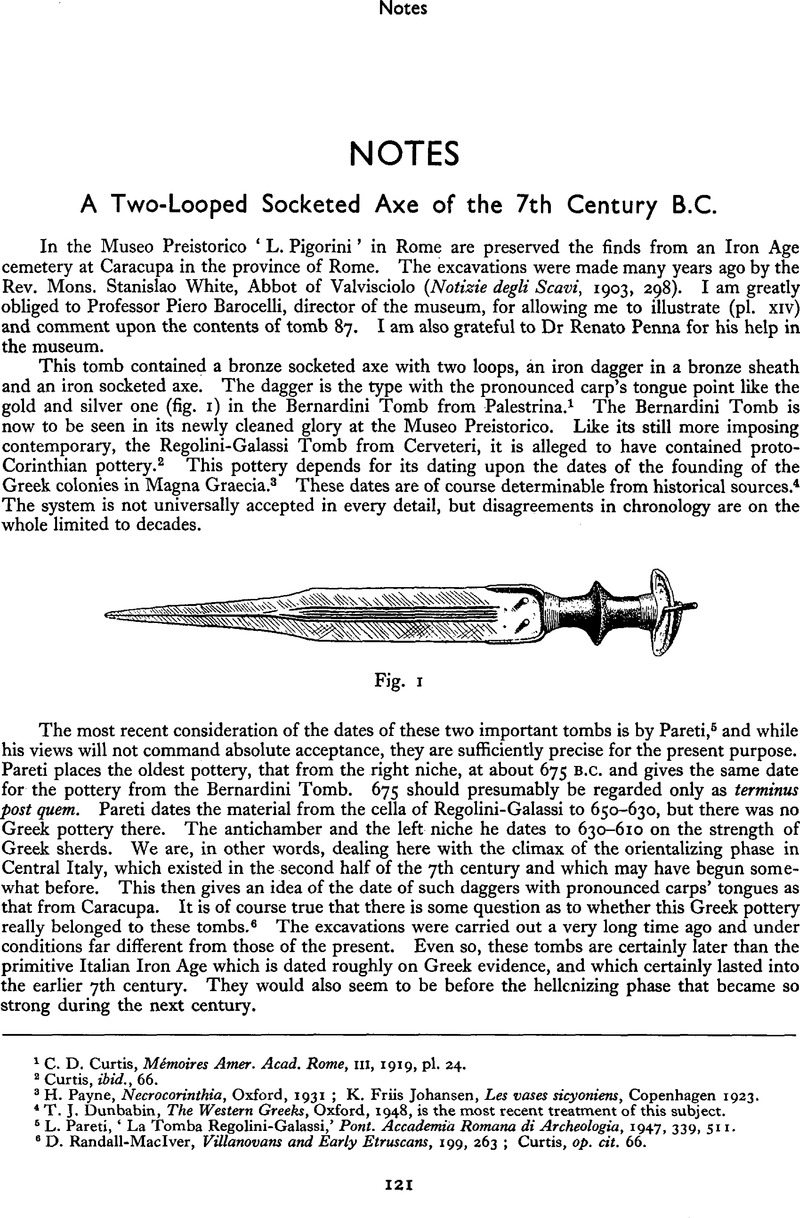No CrossRef data available.
Published online by Cambridge University Press: 27 May 2014

page 121 note 1 Curtis, C. D., Mémoires Amer. Acad. Rome, III, 1919Google Scholar, pl. 24.
page 121 note 2 Curtis, ibid., 66.
page 121 note 3 Payne, H., Necrocorinthia, Oxford, 1931Google Scholar; Johansen, K. Früs, Les vases sicyoniens, Copenhagen 1923Google Scholar.
page 121 note 4 Dunbabin, T. J., The Western Greeks, Oxford, 1948Google Scholar, is the most recent treatment of this subject.
page 121 note 5 Pareti, L., ‘La Tomba Regolini-Galassi,’ Pont. Accademia Romana di Archeologia, 1947, 339, 511Google Scholar.
page 121 note 6 Randall-MacIver, D., Villanovans and Early Etruscans, 199, 263Google Scholar; Curtis, op. cit. 66.
page 122 note 1 Montelius, op. cit., 317, 10.
page 122 note 2 Italic Tomb Groups, University Museum, Philadelphia, 1942Google Scholar, pl. XVIII.
page 122 note 3 Monumenti Antichi 16, 1906–1907, 291Google Scholar, fig. 30.
page 122 note 4 I have prepared a list of ‘rudimentary’ Italian carp's tongue swords (probably 8th–7th century B.C.) and pronounced ones (7th century) for publication in Zephyrus.
page 122 note 5 JRS, 1935, 140Google Scholar.
page 122 note 6 Dunbabin, op. cit., 462.
page 122 note 7 Montelius, op. cit., 193, 11.
page 122 note 8 Montelius, op. cit., Text, 895.
page 122 note 9 Levi, D., Corpus Vasorum Antiquorum, Italia VIIIGoogle Scholar, pl. 373, 16.
page 122 note 10 Necrocorinthia, 269.
page 122 note 11 Savory, H. N., PPS, 1949, 132Google Scholar, fig. 3; MacWhite, E., ‘Estudios sobre las Relaciones atlánticas’, Disertaciones Matritensis, II, 1951Google Scholar, fig. 18.
page 122 note 12 Taramelli, A., Monumenti Antichi, vol. 27, 1921–1922, 25Google Scholar; Notizie degli Scavi, 1915, 89Google Scholar.
page 122 note 13 E. Cartailhac, op. cit., 240; Montelius, op. cit., Text, I, Stockholm 1895, 337–8.
page 122 note 14 Cartailhac, E., Les ages préhistoriques, Paris 1886Google Scholar, fig. 343.
page 122 note 15 Cartailhac, op. cit., fig. 344.
page 122 note 16 The Barrow Diggers, pl. V, p. 78, not available to me.
page 122 note 17 Arch. Journ., III, 1846, 257Google Scholar and VI, 1849, 385.
page 122 note 18 Montelius, , Minnen från vår Forntid, Stockholm 1917Google Scholar, no. 1184 Cartailhac, op. cit., figs. 349, 350.
page 122 note 19 von Miske, K., Archiv für Anthropologie, vol. 50, 1930Google Scholar, pl. V, 20.
page 122 note 20 Tallgren, , Eurasia Septentrionalis Antiqua, II, 1927, 179Google Scholar; Jettmar, K., Bulletin of the Museum of Far Eastern Antiquities, Stockholm, No. 22, 1950, 83Google Scholar; von Merhart, G., Die Bronzezeit am Jenissei, Vienna, 1926Google Scholar.
page 123 note 1 Karlgren, B., Bull. Mus. Far East Antiq., 17, 1945, 101Google Scholar.
page 123 note 2 Ant. J., XIX, 1939, 322Google Scholar; also Savory, , PPS, 1949, 132Google Scholar, fig. 3.
page 123 note 3 MacWhite, op. cit., pl. XV.
page 123 note 4 op. cit., 240.
page 123 note 5 Presumably Montelius, op. cit., 67, 17.
page 123 note 6 Montelius, op. cit., 195, 25.
page 123 note 7 Taramelli, , Mon. Ant., 27Google Scholar, fig. 46.
page 123 note 8 Minto, A., Notizie degli Scavi, 1926, 374Google Scholar.
page 123 note 9 Taramelli, A., Studi Etruschi, III, 1929, 43Google Scholar.
page 123 note 10 Ampurias, II, 85Google Scholar.
page 124 note 1 Ampurias, II, 119Google Scholar.
page 124 note 2 Åberg, , Chronologie, I, 80Google Scholar.
page 124 note 3 Åberg's scheme is weak here, for he makes his period II, I (before the Etruscan) stop short with II, 2 (the Etruscans) when the two really overlapped. The real chronological clues are the native Iron Age civilization at Cumae that terminated with the Greek settlement about 750 and contacts after 750 between the other peoples of Italy and the Greeks. It should also be added that since Åberg's work was published in 1930, the dates of Greek and related painted wares in Italy have been reduced.
page 124 note 4 Almagro, , Ampurias, IIGoogle Scholar, pl. III, esp. two daggers at the upper left.